Poll reveals some educators don’t know how to identify pupils with hearing and/or sight loss

A recent webinar for educators has shown results in a poll of delegates including heads of special educational needs (SEN), headteachers and other senior leaders in primary and secondary schools regarding pupils with mild to moderate hearing and sight loss.
The webinar focused on identifying and supporting these pupils as part of school inclusion and welfare programmes and included an extensive question and answer session (Q&A) with Thomson Screening’s clinical leadership.
The event was organised by the Mark Allen Group, which also runs the TES magazine SEND conference, and was supported by Thomson Screening, a provider of software that enables non-clinicians to deliver vision and hearing screening in schools and workplaces.
Of the 510 attendees, 92% gave high importance to identifying and supporting children with mild to moderate vision and hearing loss.
At the beginning of the webinar a poll was taken, asking: “How would you rate your understanding of visual and hearing impairment in children and young people, including the signs to look out for, the impact of these conditions on their educational and social development, and how students need to be supported in school?”
Although the webinar was attended by educators responsible for inclusion and welfare, only 31% of respondents rated their understanding as good (24%) or very good (7%). And almost half responded that their understanding was simply “fair”.
Towards the end of the webinar a second poll took place, this time asking delegates what the largest benefits to their school of checking pupils for vision and hearing deficits might be. Here the results were strikingly conclusive; an overwhelming 92% responded that the largest benefit would be to ‘identify and remove academic barriers for students’.
Michael Ter-Berg, CEO of Thomson Screening, which developed SchoolScreener for schools’ screening software, said: “We were surprised that so few of the educators attending felt their understanding was good or above.
“That said, the aim of the webinar was to address how schools can easily check children as they develop through Key Stages 2 and 3 and how to support these children as part of school welfare and inclusion activities.
“Those attending, and the feedback we received, overwhelmingly reassured us that delegates went away from the webinar feeling far more secure in their knowledge and understanding of identifying and supporting young people with mild to moderate vision and hearing problems.”
Michael continued: “The 92% figure demonstrates the importance of checking children’s eyesight and hearing as they develop through Key Stages 2 and 3.
“It also underscores the importance of research showing that children with vision and hearing are more likely to miss Key Stage 2 targets and underperform at GSCE, as well as other research in recent years identifying the impact of unidentified vision and hearing loss on social development and behaviour.”
To further support educators and schools all 1,344 registrants also received a link to the recording, a PDF summary produced by the organisers and responses to questions asked from panel clinicians Professor David Thomson and Dr Sebastian Hendricks.






